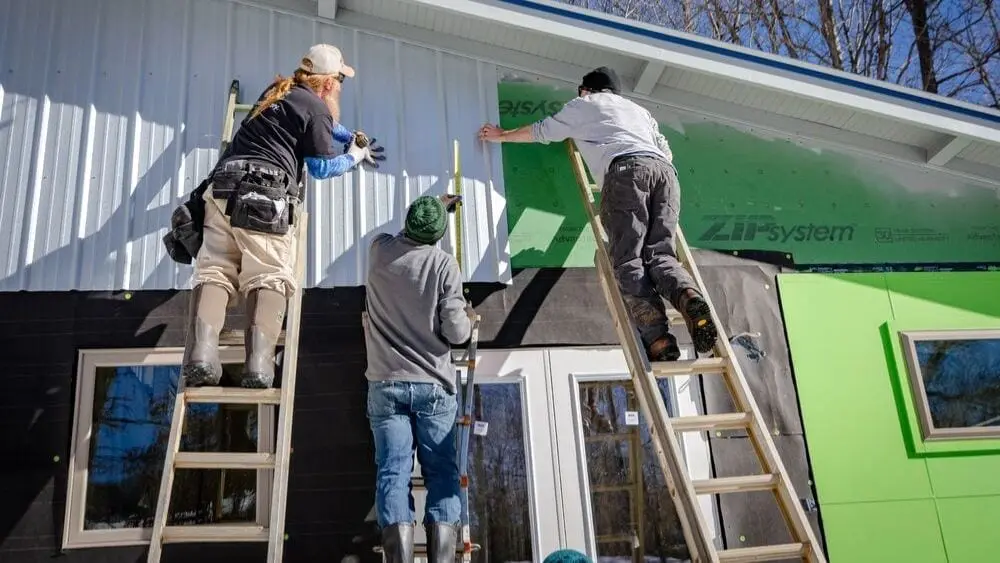
When you’re ready to start your new home shopping spree, you may have visions of glittering granite counters, a sunroom with French doors that open onto a terrace or a pristine master bath with heated flooring to warm your toes every morning.
This wide array of choices, while definitely appealing, can bring with it a little bit of uncertainty. Don’t worry, we’ll hold your hand as you go through the process of selecting an area of town where you want to live, a community with the amenities you want, a builder you can trust, and a home you can love.
What Do You Want in a New Home?

While educating yourself about your local market, builders, and new home communities in your area are important steps in your new home journey, the place to start is to determine what you really want in a home.
Purchasing a home is the largest financial decision that many people make. Investing time to define the must-have features (as well as the would-be-nice and can-live-without features) of your dream home is important.
Also, think about your long-term goals and financial plans. Financial advisors recommend owning a home for at least five to seven years before you sell it. That time allows for the market value of your home to appreciate, which can help you recoup your real estate and moving costs. Decide if you’re ready to make the commitment to a home and a community for at least that long.
Of course, when you’re buying a home that you’ve personalized to match the way you want to live, you may never want to move. If you think the home you build will be your “forever home,” it’s wise to consider how you and your family will change over time. For example, if you have children, plan for their changing needs as they grow, leave home and perhaps return. You may want to plan for flexible space on the first floor for aging parents who may one day live with you.
An area to give particular thought to is the location of the master bedroom. Many parents of infants and young children prefer to have an infant’s bedroom near their own bedroom. That may change in the teenage years, when all parties may prefer privacy and separation. And you may prefer a first-floor master bedroom for yourself as you age.
Thinking about the features that you and any family members need — now and in the future — will help you clarify what’s most important to you in your next home.
Dale C. Adams, Jr., new home sales manager of JLS Design and Construction in Maryland, helps prospective buyers clarify their priorities by asking this series of questions:
- How long have you been looking for a new home?
- When do you want to move?
- Do you own or rent now?
- What do like about where you live now?
- What do you dislike about where you live now?
- What are you looking for in a home?
You can get a head start on your home search by asking yourself these questions.
“I also ask people if they have an idea of how much they want to spend for their home,” Adams says.
“Sometimes they’ll say $250,000, but when I ask them if they have a monthly payment in mind they’ll say $2,000. A lot of new buyers don’t realize that they might be able to buy a $330,000 home for that amount.”
Figure Out How Much You Can Spend

While you’ll need a loan preapproval from a lender when it’s time to seriously shop for a home, you should develop your own budget and an idea of what you can spend on a home before you begin looking at homes. Some buyers opt to look at new home communities first so they can get an idea of what’s available at different prices, but the danger of doing that is the potential to fall in love with a community or a home design that’s far out of your financial reach. So, what steps should you take to determine how much you can spend on buying a new home?
Start your financial planning at the same time as you compile your wish list by requesting your free credit report from www.annualcreditreport.com. You should get your credit report from all three credit bureaus (Experian, Equifax, and TransUnion) at the same time and check for errors. For a small fee, you can also see your credit score.
A 2013 Federal Trade Commission report found that 20 percent of all credit reports contain mistakes. Correcting an error can take months and impact your ability to qualify for a mortgage loan, so taking this step first can save you time and frustration later in the process of buying a new home.
Second, identify your source of cash for your new home. Many move-up buyers sell their current homes to generate down payment funds. You can get a general idea of how much equity you’ll have to use for your next home purchase by estimating your current home value on recent local sales, estimating that you’ll need to pay 6 percent to 10 percent of the sales price for closing costs and commissions and then subtracting your current mortgage balance.
For example, if the estimated value of your current home is $400,000, you’ll pay a maximum of about $40,000 in commissions and closing costs for a remainder of $360,000. If your mortgage payoff is $200,000 you’ll have $160,000 to use towards your new home, moving costs and cash reserves.
In addition to, or in lieu of selling your prior home, you may have savings and investments you plan to use for a down payment. Many first-time buyers also rely on gifts from parents or grandparents. Steven Cohen, vice president of First Place Bank in Rockville, Maryland, says prospective buyers should make sure they clearly understand how much money a relative intends to give them for a home.
“I’ve worked with people who assumed their parents were giving them $20,000 when the parents intended to give them $2,500”, he says.
Next, estimate what your monthly payments would be for particular loan amounts. Most builders and lenders have online calculators that you can use to plug in different numbers. The rule of thumb used to be that you could spend 2.5 times your salary on a home purchase. The reality today is that mortgage lending standards are much more complex and depend on your income, assets, credit profile, and other debt. The majority of loan programs require borrowers to have a maximum debt-to-income ratio of 43 percent, so one way to estimate the maximum you can borrow is to calculate your own ratio based on your monthly gross income and the minimum payments on all recurring debt. Many financial planners recommend a maximum housing payment of 28 percent to 30 percent of your gross income.
A lender will preapprove you for a mortgage based on your documented debt-to-income ratio and credit, but it’s extremely important for you to decide for yourself your comfort level with a particular monthly payment. A mortgage lender won’t know about some of the expenses that you have, such as maintaining a high level of contributions to a college savings fund or a retirement account or even some discretionary spending on things that matter to you, such as playing golf every weekend or taking frequent ski vacations. If you don’t already have a detailed monthly budget, you should at least sketch out a general budget so you can see how a new mortgage payment will fit into your financial plans.
The emphasis here is on a monthly payment because while buyers often search for a home in a particular price range (such as $250,000 to $275,000), spending as much as $10,000 above your maximum price may not have as much impact as you think. For example, a $275,000, thirty-year fixed-rate loan at an interest rate of 5 percent will have a monthly principal and interest payment of $1,468. A loan for $285,000 with the same terms will have a monthly principal and interest payment of $1,521, just $53 more per month and only $1.70 more per day.
“A lender can tell you how much you qualify for, but they can also work with you to match a loan amount to the monthly payment you want to make,” says Mike Kelly, senior vice president for Prospect Mortgage, one of the nation’s largest independent mortgage lenders.
You can use the estimated principal and interest in a mortgage calculator to generate an idea of how much you can borrow at different mortgage rates and loan terms and with various sizes of down payments.
If you make a down payment of less than 20 percent, you’ll need to pay mortgage insurance, so you should factor that into your monthly payment. Many mortgage calculators offer the option of showing your payment with an estimated mortgage insurance payment.
Bring in the Professionals

While it’s great to do a lot of your own research online and in-person to get a sense of what’s available where you want to live, at some point you’ll want to turn to professional experts to help you move forward on your plans. The professional expertise you need depends on your own level of experience and confidence as a buyer of a newly built home.
For example, if you plan to pay cash, you don’t need to consult a lender.
If you have a clearly defined idea of your dream home and already know the work of several builders in your area, you won’t necessarily need to hire a Realtor.
However, if you need to finance your purchase or want outside expertise to guide you in your decisions, then you may want to interview several lenders and Realtors to make an informed choice for your support team.
Schedule a Lender Consultation

You should already have a general idea of your comfort level with your housing budget, but now it’s time to get serious about arranging financing for your new home. If you’re a first-time buyer, you should expect to spend an hour or more with a lender learning about loan programs and discussing your finances. If you already own a home and are buying your first newly built home, you may already have your financial plan in place and a loan program identified.
Your financing options are different depending on whether you’re working with a production builder or a custom home builder. Financing a newly built production home is in many ways similar to financing the purchase of an existing home except that you may need to wait until your home is closer to completion to lock-in your loan and interest rates. If you’re buying a quick delivery home that you’ll purchase and move into within 30 to 60 days, your financing process will be the same as if you were purchasing a resale property.
Most large and midsize builders have either an in-house or affiliated lender or a list of preferred lenders that buyers can work with to arrange financing. As a buyer, you have the choice of working with the builder’s lender or arranging a loan with a different lender. In many cases, your builder will offer incentives such as closing cost assistance or provide one or more free options if you opt to use the preferred lender and settlement company.
Whether or not you use a builder’s preferred lender, it’s important to use a lender who’s experienced with the home building process, says Phyllis Casillas, a sales manager for On Q Financial, Inc. in Tempe, Arizona.
“The major difference between financing a newly built home and a resale is that when you’re buying a new home, you have to wait to secure your interest rate,” Casillas says. “When you’re buying a resale, you usually can lock in your rate as soon as you have a contract.”
An experienced new home lender can give you advice about when you should lock in your rate and help you find the right loan to meet your needs.
“You have a window of unknown on rates, so don’t wait to be surprised,” she suggests. “For instance, if rates are 4.5 percent vs. 5.5 percent, ask the lender what the difference in payment would be and whether you qualify at the higher rate.”
Production builders have recommended lenders or in-house lenders because they want to make sure that the buyer’s financing is secure and in place when the home is finished. During the construction process, the financial outlay, and therefore all of the risk, is taken on by the builder (other than your deposit), so it’s natural for a builder to be particularly concerned that you’re able to purchase the home. If your financing were to fall through, the builder would be forced to put a home on the market that has been designed to your specifications. It can be difficult to sell a home that’s been completed in a new development since most buyers in new communities are excited to be able to personalize their own homes.
“It’s smart to work with a lender who’s recommended by your builder because these lenders are familiar with the community and will help make sure you get to the closing,” says Caryl Dierksen, a homebuyer in an Epcon Community in Woodstock, Illinois. “I know some people who used a different lender and had a lot more trouble, especially because they were working with an out-of-town lender, not a local one.”
Working with the builder’s recommended lender could be beneficial to you in several ways. Not only does this give you the advantage of access to builder incentives, but the application process could be faster and simpler since the lender wants to satisfy the builder as well as provide you with financing. You also know for certain that you’re working with a lender who’s experienced with new home financing and comes recommended by your builder. The lender then becomes part of the team of people working to get your new home built and financed to meet your needs.
However, you should also shop around to make sure that the rates and fees you’re quoted and the loan programs that are available to you are similar to those available from other lenders. Compare the interest rates and the cost of the loan from the builder’s lender (or recommended lender) with those from one or two outside lenders. If the interest rate you’re offered by the builder’s lender is higher, you need to weigh the financial benefits offered by the builder (such as closing costs or upgrades to your home) against the additional interest payments you would make over the life of the loan. In most cases, the preferred or affiliated lenders recommended to you by your builder will offer competitive financing, but it’s wise to spend a little time shopping around to be certain.
If your builder doesn’t have an in-house lender or you simply want to shop around before committing to a lender, plan to interview two or three lenders. It’s important to find a lender you can trust. After all, you’re providing access to your deepest financial secrets, so you need to be comfortable sharing your money habits and willing to develop a relationship with your lender. The best way to find a lender is to ask for recommendations from your builder, a real estate agent, and from your friends or colleagues who have recently bought a home. You can also start with your bank or credit union to consult with a lender or contact a community bank.
Mortgage Loan Qualifications

The essential elements of qualifying for a loan, including a review of your credit history, job history, income and assets, are the same regardless of whether you’re applying for a mortgage to build a home from a production builder or to buy an existing home. When you’re shopping for a home, regardless of whether you’re looking for a new home or a resale, it’s best to consult a lender and get prequalified or even preapproved for a loan. A prequalification for a mortgage is based on your verbal statements about your income, assets, debts and credit score, although many lenders will also do a quick credit check as well. A preapproval requires you to provide documentation to a lender.
“You should go through the loan application process and get preapproved for a loan,” PenFed Credit Union’s Craig Olson says, “but you’re not obligated at all to actually finance your home with that particular lender. A preapproval letter is a promise to provide financing based on an applicant’s documented information, but it’s contingent on the borrower actually finding and making an offer on a property. You can switch to a different lender when you’re ready to buy, although you’ll have to provide complete documentation to that new lender.”
When you’re shopping for a resale home, sellers typically refuse to accept an offer from a buyer who lacks mortgage preapproval. The strength of your loan preapproval is particularly important if you’re competing against other buyers for a property. If you’re buying a new home, a mortgage approval should function as a check-up to make sure your finances are in order and as a way to establish your price range.
“A mortgage preapproval determines how much you can spend not only on the home itself but also on the optional features you want,” says Mike Kelly, senior vice president for Prospect Mortgage. “Your lender will determine the maximum amount you can borrow and then you’ll discuss your available assets for the down payment and closing costs to determine your total sales price. For instance, if you qualify for a $300,000 loan and you have $30,000 in cash for the down payment then you can only spend up to $330,000 on the base price and all the options. It’s smart to do this before you look at options so you don’t sign a contract for $350,000 including options and then have to reset your expectations for what you can afford to add to your home.”
Mortgage lenders will evaluate your income, your assets, your debt-to-income ratio, your credit score and profile, and your job history. You’ll need to provide documentation in the form of tax returns, bank statements, W2 forms, your employer’s name and address, and recent paystubs. It will save you time if you gather these items before you meet with a lender.
“Every lender is different, but most require a credit score of 640 or perhaps 620 if you have compensating factors such as a good job history or a lot of cash reserves and are applying for a government-insured loan such as an FHA, VA, or USDA Rural Housing Development mortgage,” On Q Financial’s Phyllis Casillas says. “You’ll need a credit score of at least 740 to qualify for the lowest interest rates on a conventional loan.”
A lender will also look at your debt-to-income ratio, which compares your gross monthly income to your entire housing payment (principal, interest, property taxes, homeowners insurance, and any HOA fee) and the minimum monthly payment on all other debt, such as your car payment, student loans, and credit card debt. The maximum debt-to-income ratio lenders will allow is 43 percent. For example, if you make $120,000 a year, your gross income would be $10,000 per month, so your housing payment plus the minimum payment on all other debt such as your car, credit cards and student loans, would have to be $4,300 or less, Cohen says.
Many factors go into a loan approval, such as your job history and your cash reserves, which is why it’s so important to talk directly to a lender as early as possible in the home shopping process about your individual circumstances. Even if you have a foreclosure or bankruptcy in your past, you may still qualify for a new mortgage depending on how long ago it happened and why. Lenders are well aware of the difficulties many families experienced during the recession. If you can document that you had good credit prior to a job loss or reduction in hours and your credit has since recovered, you’re in a better position than someone who has consistently mismanaged money with an overload of credit card debt. A lender can work with you to reestablish your credit or give you advice so that you’ll be able to qualify for a mortgage as soon as possible.
Once you’re comfortable with the financial side of your new home purchase you can get back into looking for the builder, community and home that suits your budget and your needs.
How to Choose the Right Builder

There’s a builder for every budget — from affordable homes to luxury mansions. You have likely narrowed down your choice of builder based on your budget and your priorities in terms of a neighborhood or a particular home style. Before you settle on one particular builder, you should do a little more research to get a sense of the builder’s reputation and quality, if you haven’t already.
Erin Hungerford, a Realtor with Long & Foster Real Estate in Richmond, Virginia, says Realtors can help you recognize the level of quality in different homes and can share their expertise and knowledge about particular builders. Realtors who sell new homes discuss various builders among themselves and talk about their clients’ experiences with different builders, so they can be a great source of information.
You can also ask the builder for references. Even though those references are likely to be satisfied customers, you can get a sense of what those homeowners particularly appreciate about their builder to see if that matches what you want in a builder. And, when you visit a particular community, ask if the builder provides a written warranty. If residents haven’t moved into a community where you want to live, you can always go to completed communities by the same builder to ask homeowners there about their experience.
Karen McCaffrey with McCaffrey Homes says that to determine whether a builder is offering a quality product, “you should look at the list of included features to see what materials are being used for counters, vanities, and flooring. Check to see if the roof has a thirty-year warranty and look at the exterior materials being used.”
Dale Adams of JLS Design and Construction recommended not only looking at the model home, but also asking to visit similar houses that are still under construction to see what they look like without optional features.
By this time you’ve likely identified a couple of builders that you think could suit your needs. Let’s take a look at how to pare down that list to the ideal builder for your needs.
As you learned earlier, home builders are typically identified as either custom builders or production builders, but most builders fall somewhere in between pure custom builders who work with an in-house architect or your architect to create a unique home and production builders who offer varied options. Along the spectrum, you’ll find builders who offer complete customization of their own floor plans, including moving walls and redesigning spaces, and other builders who offer an “A,” “B,” or “C” choice of finishes but won’t let you make structural changes to their plans.
You may have already decided that you want to build a custom home on your own land, but if you’re not sure if you want a production home or a custom home, there are several issues to consider:
Your Timeline

If you need to move into your new home by a particular date, then a production home may be the better choice. In addition, for buyers who especially wish to move more quickly, look for so-called spec homes or quick move-in homes. Spec homes are typically built on speculation (hence the name) rather than to the design of a specific homebuyer. Many builders equip spec homes with their most popular options, so while you may not be able to select your favorite color or type of countertop, for example, you can move in much more quickly and know that your home reflects popular design choices that should pay off some day if you sell the home.
Some builders may also offer quick move-in homes that may be partially constructed when you purchase them, but still allow you some range of choices in colors and options, depending upon the degree of construction at the time of purchase. And some homes that were initially ordered by a specific buyer may end up back on the market. In this case, your choices may be whether or not you like design choices the would-be buyer selected.
Many buyers are attracted to new homes because they love the thrill of designing and building “my home, my way.” When you do so, most builders have a good idea of how long it will take to finish each home, since they typically have a well-honed system for the permit process and inspections and a pipeline for supplies. In addition, most production builders have crews of construction workers (many times regular subcontractors) that they can rely on to complete projects. Custom builders, simply because they typically build fewer homes each year, generally have a smaller staff of employees but may also have a strong team of core sub-contractors. Of course, by their nature, custom homes vary widely, so the time it takes to build one depends heavily on the size of the residence, the intricacy of the design, the availability of materials, and whether the land is ready for building or requires extensive prep work.
“Building a custom home can take as long as six months to design and to obtain permits, followed by another year to build,” says Jim Rill, owner of Rill Architects.
A production home, depending on the size and complexity of the design and the weather, takes roughly five to seven months to build, says Karen McCaffrey, vice president of McCaffrey Homes in Fresno, California. She says that sometimes it’s possible to build a small home in four months during the summer when there’s less likelihood of extended weather problems.
Your Budget
Custom homes can vary according to the limits of your imagination, zoning laws, and budget, but they’re not necessarily more expensive than production homes. After all, you can build a small, one-level rambler on a budget and it qualifies as a custom home if it’s built according to your own plan. However, most custom homes will be costlier to build than a similar production home simply because production builders have the advantage of economies of scale when it comes to the cost of labor and materials.
Your Desired Personalization

The decision about whether to build a custom home or work with a production builder depends heavily on how much you want to put your own stamp on your home. Custom homes are usually chosen by buyers who have a strong sense of what they’re seeking in a home, according to McCaffrey. On the other hand, many production builders offer semi-custom homes that allow you to make a variety of changes to the floor plan and features to build the home of your dreams.
Don’t Forget About Resale Potential
When you’re shopping for a home, a builder, and a community, you’re probably focused pretty tightly on what will meet your needs now and in the future. However, many people own a home for five to seven years and then sell it and move to another. While your decisions about where and what to buy shouldn’t be dictated solely by resale potential, you should keep in mind that you’re making a major investment.
Some simple online research or a Realtor can help you understand historical real estate values in a particular area and the key factors that can influence home values, including the school district, transportation, nearby retail and infrastructure and future development. In addition to looking at neighborhood values, keep in mind the context of the rest of the community. Real estate experts often say it is best not to own the most expensive house in the neighborhood because it can be harder to sell than one that better fits in with other homes in the area.
“A Realtor can give you professional advice so that you don’t overbuy on options in comparison with the rest of the neighborhood,” Century 21 Beal, Inc.’s Raylene Lewis says.

Michele Lerner is an award-winning freelance writer, editor and author who has been writing about real estate, personal finance and business topics for more than two decades.
 Considering Resale Value When Building a Custom Home on Your Lot
Considering Resale Value When Building a Custom Home on Your Lot
Carolyn Manning
Thank you for your consideration.